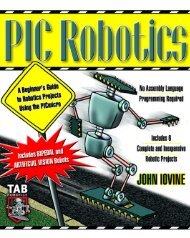Sensors and Methods for Mobile Robot Positioning
Sensors and Methods for Mobile Robot Positioning
Sensors and Methods for Mobile Robot Positioning
Create successful ePaper yourself
Turn your PDF publications into a flip-book with our unique Google optimized e-Paper software.
Chapter 5: Dead-Reckoning 149<br />
In order to test the effectiveness of their method,<br />
Komoriya <strong>and</strong> Oyama also conducted actual<br />
experiments with Melboy, the mobile robot shown<br />
in Figure 5.16. In one set of experiments Melboy<br />
was instructed to follow the path shown in<br />
Figure 5.17a. Melboy's maximum speed was<br />
0.14 m/s (0.5 ft/s) <strong>and</strong> that speed was further<br />
reduced at the corners of the path in Figure 5.17a.<br />
The final position errors without <strong>and</strong> with gyro<br />
in<strong>for</strong>mation are compared <strong>and</strong> shown in<br />
Figure 5.17b <strong>for</strong> 20 runs. Figure 5.17b shows that<br />
the deviation of the position estimation errors from<br />
the mean value is smaller in the case where the<br />
gyro data was used (note that a large average<br />
deviation from the mean value indicates larger<br />
non-systematic errors, as explained in Sec. 5.1).<br />
Komoriya <strong>and</strong> Oyama explain that the noticeable<br />
deviation of the mean values from the origin in<br />
both cases could be reduced by careful calibration<br />
of the systematic errors (see Sec. 5.3) of the mobile<br />
robot.<br />
We should note that from the description of this<br />
experiment in [Komoriya <strong>and</strong> Oyama, 1994] it is<br />
not immediately evident how the “position estimation<br />
error” (i.e., the circles) in Figure 5.17b was<br />
found. In our opinion, these points should have<br />
been measured by marking the return position of<br />
the robot on the floor (or by any equivalent<br />
method that records the absolute position of the<br />
Figure 5.16: Melboy, the mobile robot used by<br />
Komoriya <strong>and</strong> Oyama <strong>for</strong> fusing odometry <strong>and</strong> gyro<br />
data. (Courtesy of [Komoriya <strong>and</strong> Oyama, 1994].)<br />
robot <strong>and</strong> compares it with the internally computed position estimation). The results of the plot in<br />
Figure 5.17b, however, appear to be too accurate <strong>for</strong> the absolute position error of the robot. In our<br />
experience an error on the order of several centimeters, not millimeters, should be expected after<br />
completing the path of Figure 5.17a (see, <strong>for</strong> example, [Borenstein <strong>and</strong> Koren, 1987; Borenstein <strong>and</strong><br />
Feng, 1995a; Russel, 1995].) There<strong>for</strong>e, we interpret the data in Figure 5.17b as showing a position<br />
error that was computed by the onboard computer, but not measured absolutely.<br />
5.5 Summary<br />
&<br />
&<br />
Odometry is a central part of almost all mobile robot navigation systems.<br />
Improvements in odometry techniques will not change their incremental nature, i.e., even <strong>for</strong><br />
improved odometry, periodic absolute position updates are necessary.




